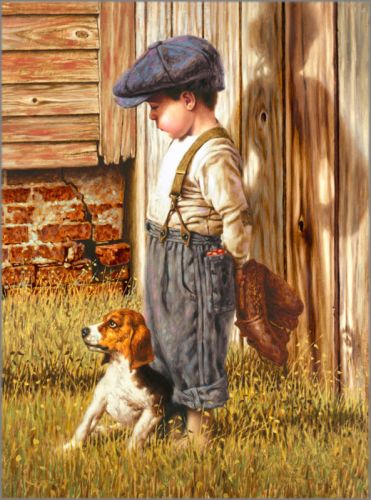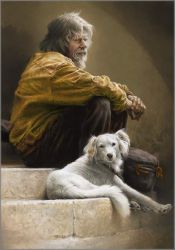Something artful to aMUSE you…
Greetings and salutations from Clancy, your humble Patron of
the Arfs (and potential artist’s muse)!
As you undoubtedly know, dogs are considered man’s best
friend, and rightfully so. Saint Bernards have traditionally warmed lost Alpine
climbers with flasks of brandy. Dogs serve as seeing-eye dogs and provide
assistance for a wide range of human conditions as emotional support animals. They
search for bombs to keep people safe. And, it seems, dogs have often served as furry,
four-legged muses to inspire artists; hence this week’s blog about famous
artists who paint dogs. (Can you blame them?)
 Take, for instance artist Pablo Picasso (1881 – 1973), who had
many loves during his life. Aside from his multiple wives and assorted mistresses,
Picasso loved dogs, one of whom was his Dalmatian “Perro” (Spanish for dog). Lump
was Picasso’s cherished Dachshund. The artist is shown below with both dogs and
an original drawing of Lump. He remarked: “It took me a whole lifetime to learn
how to draw like a child again.” (Thanks, I’m sure, in no small part to Perro
and Lump.)
Take, for instance artist Pablo Picasso (1881 – 1973), who had
many loves during his life. Aside from his multiple wives and assorted mistresses,
Picasso loved dogs, one of whom was his Dalmatian “Perro” (Spanish for dog). Lump
was Picasso’s cherished Dachshund. The artist is shown below with both dogs and
an original drawing of Lump. He remarked: “It took me a whole lifetime to learn
how to draw like a child again.” (Thanks, I’m sure, in no small part to Perro
and Lump.)
Artist George Rodrigue (1944 – 2013) of Louisiana painted his
famous Blue Dog series based on a photo of his late dog, Tiffany. Loyal pooch
that she was, she sat beside the Cajun artist’s easel to keep him company as he
painted late into the night. When viewing the Blue Dog paintings, people would
often stare at its eyes and begin to cry. Rodrigue noted: “The yellow eyes are
really the soul of the dog. He has this piercing stare. People say the dog
keeps talking to them with his eyes, always saying something different.” Among
the many philanthropic causes Rodrigue established is Blue Dog Relief, raising
millions for humanitarian aid after both 9-11 and Hurricane Katrina.


Bessie Pease Gutmann (1876 – 1960) was an American artist
and illustrator. Her husband, Hellmuth Gutmann and his brother, Bernard, had
founded the fine art publishing company, Gutmann and Gutmann in New York in
1902. Bessie and Hellmuth married in 1906 and settled in South Orange, NJ.
Setting up a studio in their home, Bessie painted their three little ones and
became one of the era’s leading artists to portray the innocence of children. Her
famous painting, In Disgrace, depicts
her tearful toddler, Lucille, nose to the wall in utter shame. Teddy, Lucille’s
puppy, longs to console her and snuggles her to share the blame, looking back
at the viewer with an irresistibly sad expression.
Artist Jim Daly’s Tough
Love presents a contrite little boy standing in the shadow of his mother.
Her posture is stern, his remorseful. The empty glove suggests the missing
baseball may be the culprit. The boy’s loyal dog is his ally, shielding him while
sharing the blame. Writes Daly: “When I was a boy, I was in the doghouse
more than once, and I believed that all of my troubles would be over when I
grew up. Life's problems, however, are with us always, and when they seem to be
overwhelming and impossible to overcome, there is no way of measuring the unconditional
love of a friend.” (Especially a furry one with a cold, comforting nose!)
Canadian artist Michael Dumas
painted Gypsy, inspired by a trip
abroad:
“The subject for this piece was
observed in the French city of Arles, just inside the entrance of a narrow side
street that accessed the busy central square. In this relative calm and quiet
location, the man seemed lost in thought, trusting his four-footed companion to
warn him of the approach of strangers. The contrast between the man's contemplative
mood and the dog's alertness interested me greatly, and in the painting I
pushed the thread of this idea as far as I could. Placing the dog between any
observer and his master, and with his gaze directed straight at the viewer,
there is little doubt of the dog's unwavering diligence. As a last touch, I
added an arched shadow into the area at upper right, hoping to enhance the idea
of a protective space. This shape was inspired by observing its real-life
counterpart in the many access points to the old Roman Coliseum just a few
streets away.”
American pop artist Andy Warhol (1928 – 1987) took his dachshund,
Archie, everywhere he went: out to dinner, to art show openings, and, of
course, to his studio where he immortalized him for posterity in his own inimitable
style.
American nostalgia artist Norman Rockwell (1894 –
1978) often painted dogs, making them central in his compositions because of
the important role they play within families. His own dog, Pitter, hung out
with him in the studio. Rockwell said, “If a picture wasn’t going very well,
I’d put a puppy dog in it.” He recommended that other artists depict
four-legged creatures “just as carefully and understandingly as you paint the
people."
So if iconic artists such as those noted here derive
so much inspiration from their furry companions, who am I to disagree? (And if
any artists out there are reading this and would like to portray a certain
handsome Lakeland Terrier and his sister, it can be easily arranged for a
nominal fee of doggie treats and belly rubs. Just give my agent a call - kiss
kiss!)
XOXO,
Clancy & Shayna
(Your Patrons of the
Arfs)












No comments:
Post a Comment